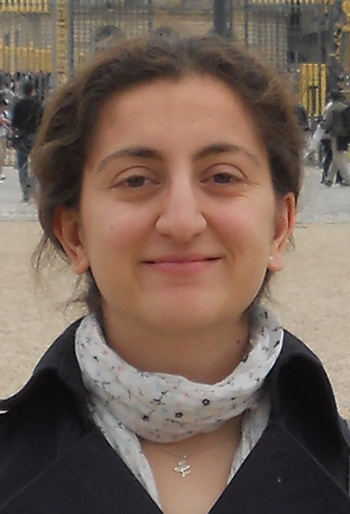cell-instructive biointerfaces with dynamic complexity
Gulistan Kocer is a PhD Student in the research group Molecular Nanofabrication. Her supervisor is professor Pascal Jonkheijm from the faculty of Science and Technology.
 The extracellular environment is a highly dynamic milieu where instructive cues (i.e., signals) that originate from the surrounding matrix and neighboring cells are tightly controlled in a spatiotemporally regulated manner. Incorporation of bioinspired dynamic cues, while designing new cell-instructive biointerfaces, has recently been an important focus in biomaterials development for regenerative medicine applications. In this line, progressive developments in materials chemistry as well as introduction of non-covalent chemistries and stimuli-responsive elements in biomaterials design has opened up tremendous opportunities to achieve such highly biomimetic cell-instructive biointerfaces with dynamic regulation of physical, chemical and mechanical cues, to guide desired cell and tissue response. In this thesis, chemical approaches to fabricate dynamic cell-instructive biointerfaces using light-responsive liquid crystal polymer networks (LCNs) and supported lipid bilayers (SLBs) are presented and discussed with an emphasis put on investigating (stem) cell behavior. In the first part of the thesis, temporal control over cell migration upon light-induced in situ changes in nanotopographical cues is achieved on azobenzene conjugated LCNs. This work introduces these materials as new biointerfaces. In the second part of the thesis, central focus is on how to exploit SLBs as dynamic cell-instructive platforms providing control over ligand density, mobility, functionalization route, composition (i.e., type of the peptide ligand) as well as peptide-SLB interactions. On SLBs, functionalized via biotin-neutravidin interactions, ligand (i.e., integrin targeting RGD) density and mobility are shown as important parameters to guide hMSC behavior. Next, using lipid insertion (i.e., using alkyl tail or cholesterol modified (lipidated) RGD ligands) as functionalization route, both lateral (in-plane) and out-of-plane dynamicity of the ligands are controlled. The length of the alkyl tail (i.e., interaction strength of lipidated peptide and SLB) that is conjugated to RGD peptide is shown to be critical to control hMSC adhesion, spreading and focal adhesion formation in these cells on laterally mobile ligands (i.e., in fluid SLBs). Using a dye-conjugated lipid-modified RGD, the dynamic presentation of the peptide is further demonstrated together with the propensity of hMSCs to take up the peptide as well as the dependency of cell migration on the lipid anchor type conjugated on RGD. In the final part, the complexity of the surfaces is tuned by controlling lipid-modified peptide compositions for mimicking cell-matrix and cell-cell junctions in fluid SLBs, to guide endothelial cell behavior. In the epilogue, first steps are explored and discussed that are taken to employ SLBs as cell-instructive interfaces on biomaterials.
The extracellular environment is a highly dynamic milieu where instructive cues (i.e., signals) that originate from the surrounding matrix and neighboring cells are tightly controlled in a spatiotemporally regulated manner. Incorporation of bioinspired dynamic cues, while designing new cell-instructive biointerfaces, has recently been an important focus in biomaterials development for regenerative medicine applications. In this line, progressive developments in materials chemistry as well as introduction of non-covalent chemistries and stimuli-responsive elements in biomaterials design has opened up tremendous opportunities to achieve such highly biomimetic cell-instructive biointerfaces with dynamic regulation of physical, chemical and mechanical cues, to guide desired cell and tissue response. In this thesis, chemical approaches to fabricate dynamic cell-instructive biointerfaces using light-responsive liquid crystal polymer networks (LCNs) and supported lipid bilayers (SLBs) are presented and discussed with an emphasis put on investigating (stem) cell behavior. In the first part of the thesis, temporal control over cell migration upon light-induced in situ changes in nanotopographical cues is achieved on azobenzene conjugated LCNs. This work introduces these materials as new biointerfaces. In the second part of the thesis, central focus is on how to exploit SLBs as dynamic cell-instructive platforms providing control over ligand density, mobility, functionalization route, composition (i.e., type of the peptide ligand) as well as peptide-SLB interactions. On SLBs, functionalized via biotin-neutravidin interactions, ligand (i.e., integrin targeting RGD) density and mobility are shown as important parameters to guide hMSC behavior. Next, using lipid insertion (i.e., using alkyl tail or cholesterol modified (lipidated) RGD ligands) as functionalization route, both lateral (in-plane) and out-of-plane dynamicity of the ligands are controlled. The length of the alkyl tail (i.e., interaction strength of lipidated peptide and SLB) that is conjugated to RGD peptide is shown to be critical to control hMSC adhesion, spreading and focal adhesion formation in these cells on laterally mobile ligands (i.e., in fluid SLBs). Using a dye-conjugated lipid-modified RGD, the dynamic presentation of the peptide is further demonstrated together with the propensity of hMSCs to take up the peptide as well as the dependency of cell migration on the lipid anchor type conjugated on RGD. In the final part, the complexity of the surfaces is tuned by controlling lipid-modified peptide compositions for mimicking cell-matrix and cell-cell junctions in fluid SLBs, to guide endothelial cell behavior. In the epilogue, first steps are explored and discussed that are taken to employ SLBs as cell-instructive interfaces on biomaterials.





